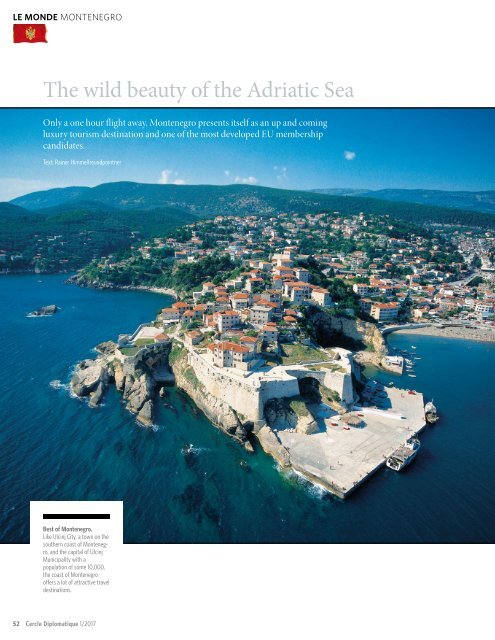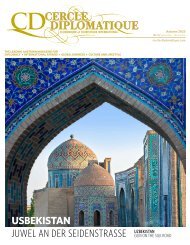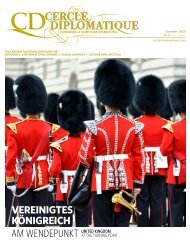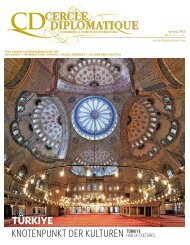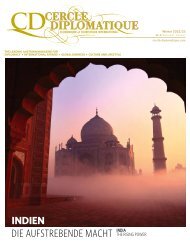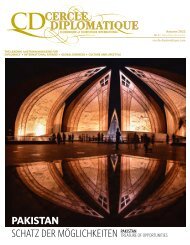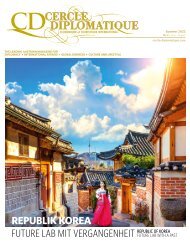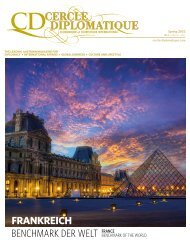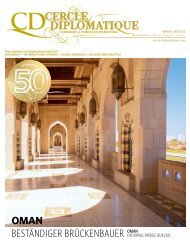CERCLE DIPLOMATIQUE - issue 01/2017
CD is a bi-lingual, independent and impartial magazine and is the medium of communication between foreign representatives of international and UN-organisations based in Vienna and the Austrian political classes, business, culture and tourism. CD features up-to-date information about and for the diplomatic corps, international organisations, society, politics, business, tourism, fashion and culture. Furthermore CD introduces the new ambassadors in Austria and informs about designations, awards and top-events. Interviews with leading personalities, country reports from all over the world and the presentation of Austria as a host country complement the wide range oft he magazine.
CD is a bi-lingual, independent and impartial magazine and is the medium of communication between foreign representatives of international and UN-organisations based in Vienna and the Austrian political classes, business, culture and tourism. CD features up-to-date information about and for the diplomatic corps, international organisations, society, politics, business, tourism, fashion and culture. Furthermore CD introduces the new ambassadors in Austria and informs about designations, awards and top-events. Interviews with leading personalities, country reports from all over the world and the presentation of Austria as a host country complement the wide range oft he magazine.
Create successful ePaper yourself
Turn your PDF publications into a flip-book with our unique Google optimized e-Paper software.
LE MONDE MONTENEGRO<br />
The wild beauty of the Adriatic Sea<br />
Contrasting impressions:<br />
While the capital Podgorica<br />
(left) is growing into a small<br />
metropolis, rural places like<br />
Budva (right) capitalise on<br />
their very special charms.<br />
FACTS &<br />
FIGURES<br />
Only a one hour flight away, Montenegro presents itself as an up and coming<br />
luxury tourism destination and one of the most developed EU membership<br />
candidates.<br />
Text: Rainer Himmelfreundpointner<br />
Best of Montenegro.<br />
Like Ulcinj City, a town on the<br />
southern coast of Montenegro,<br />
and the capital of Ulcinj<br />
Municipality with a<br />
population of some 10,000,<br />
the coast of Montenegro<br />
offers a lot of attractive travel<br />
destinations.<br />
PHOTOS: NTO, BRATISLAV TABAŠ, MARCIN KONSEK<br />
Do you remember the late 80s and 90s in Vienna,<br />
a period in which the city was as hot<br />
as a vulcano, night was turned into day, and<br />
anybody who would not want to appear as completely<br />
nuts had to hang out in certain bars and restaurants<br />
only. If you wanted to belong to the in-crowd,<br />
you simply had to show up at the Alt Wien, the Neu<br />
Wien, the Salzamt, the Salzgries or the Oswald&Kalb<br />
– the very hotspots where media met politics, where<br />
creative debated with finance, where ad went mad.<br />
All these places have not been run by Austrians – no,<br />
gastronoms from Montenegro had been throwing<br />
the show. You would be welcomed by Ivo from Podgorica,<br />
the capital, served by Bane from Budva, just<br />
a 15 minutes drive away from the famous hotel island<br />
Sveti Stefan, and sometimes you might as well<br />
have been kicked out of the place in early morning<br />
hours by Zladko from the beautiful Perast with<br />
whom you better not messed up.<br />
Those were the good old times, when Montenegro<br />
ruled the Vienna city nights. If you want to experience<br />
something similar today you can just book a<br />
one hour flight by Austrian Airlines which is serving<br />
the route Vienna—Podgorica every day. Having arrived<br />
in Montenegro, you might just explore all the<br />
atttractive dining and hangout opportunities the capital<br />
has to offer – by the way: don‘t miss ”Kastan“, a<br />
very special local dish – or set out right away to discover<br />
a country which for good reasons is labeled<br />
„the pearl of the Mediterranean“.<br />
Montenegro is sort of the wild beauty south of the<br />
Adriatic Sea and unique in many ways. Nowhere else<br />
you can find so much natural wealth, beauty, mild<br />
beaches, clear lakes, fast rivers, and gorgeous mountains<br />
in such a compact area as in Montenegro. In the<br />
morning you can wake up along the beautiful Adriatic<br />
coast, have lunch on the banks of Skadar Lake,<br />
and enjoy an evening walk in the Montenegrin<br />
mountains.<br />
So it comes at no surprise that Montenegro, which<br />
has just about the size of the Schleswig-Holstein province<br />
in Germany, is heavily trying to capitalise on<br />
its natural beauties and tourism, which contributes<br />
over 20 percent to its small GDP (see box right), is at<br />
the core of the national development strategy of<br />
Montenegro, that has gained independence from<br />
Serbia in June 2006. ”It is hard to compete with the<br />
big Mediterranean countries, since our coast has<br />
only got 295 kilometers. So we decided for a masterplan<br />
with a high-end infrastructure for luxury tourism“,<br />
Ivan Milić, the Ambassador of Montenegro to<br />
Austria, says in an interview with Cercle Diplomatique.<br />
”In the beginning, for many people this sounded<br />
like utopia. But in the meantime you can really<br />
feel this luxury approach that can compete with<br />
many resorts in the world“ (also see page 60).<br />
Montenegro has counted some 1.8 million visitors<br />
last year, and most of them have based their trips<br />
in three high-end tourism development centers from<br />
which they can take day-tours to explore other parts<br />
of the country.<br />
The first and foremost one certainly is Porto<br />
Montenegro. Located in the beautiful UNESCO protected<br />
Bay of Kotor. With the sea on the doorstep<br />
and architecture that mirrors the nearby Venetian<br />
towns of Kotor and Dubrovnik, it features a luxury<br />
Regent hotel, waterfront homes, a nautical village<br />
and a superyacht marina. And it is complemented by<br />
signature restaurants, lively bars and a wide range of<br />
sports, leisure and cultural activities. Milić: ”It is<br />
maybe the most famous tourism landmark of our<br />
country.“<br />
Then there is a major touristic and real estate development<br />
in Lustica Bay, also with luxury hotels,<br />
marina and golf course and backed by the Swiss-<br />
Egyptian Orascom Group. And finally, the finance<br />
group Azmont Investments from Azerbaijan has<br />
chosen Portonovi, which is near Herceg Novi, for<br />
another huge tourism project worth some 650 million<br />
Euro.<br />
Many of the activities have attracted Austrian<br />
companies as well to engage in Montenegro. With a<br />
volume of some 370 million Euro, according to the<br />
National Bank of Montenegro, Austria is amongst<br />
the five biggest investors there. The Erste Bank and<br />
the Steiermärkische Sparkasse as well as Uniqa insurance<br />
have opened branches in Montenegro. And the<br />
Austrian construction giant Strabag is partly involved<br />
in the Porto Montenegro project. Additionally,<br />
Austrian telecom companies are helping to build up<br />
telecommunications infrastructures in the country.<br />
And Voith, the expert in energy and power technology,<br />
is upgrading three hydro power plants as a contribution<br />
to Montenegro‘s plan to renew its energy infrastructure,<br />
since the country is only using some 27<br />
percent of its hydro potential.<br />
Thanks to this range of development efforts, Montenegro<br />
is expected to enjoy a GDP growth rate of<br />
Montenegro<br />
Official name:<br />
Montenegro – Crna Gora<br />
Capital and largest city:<br />
Podgorica<br />
Official language:<br />
Montenegrin<br />
Ethnic groups:<br />
45% Montenegrins<br />
28.7% Serbs<br />
8.6% Bosniaks<br />
4.9% Albanians<br />
Religion: 59 % Christian,<br />
23 % unaffiliated, 17 % folk<br />
religion (e.g. santeria)<br />
Government:<br />
Parliamentary republic<br />
• President: Filip<br />
Vujanović<br />
• Prime Minister: Duško<br />
Marković<br />
History:<br />
• 625: Formation of Duklja<br />
as a vassal of Byzantine<br />
Empire<br />
• 1042: Independence<br />
gained at Battle of Bar<br />
• 28 August 1910:<br />
Kingdom proclaimed<br />
• 1 December 1918:<br />
Formation of the<br />
Kingdom of Yugoslavia<br />
• 29 November 1945:<br />
Became a part of the SFR<br />
Yugoslavia<br />
• 27 April 1992: Dissolution<br />
of SFR Yugoslavia<br />
• 3 June 2006: Independence<br />
regained after the<br />
referendum<br />
Area: 13,812 km 2<br />
Population: 630,000<br />
GDP: 4.25 billion $ (2<strong>01</strong>6<br />
estimate, nominal)<br />
GDP per capita: 6,783 $<br />
(2<strong>01</strong>6 estimate, nominal)<br />
Herceg Novi - a view of<br />
the old castle tower with<br />
the historic town wall<br />
entrance.<br />
Picturesque scenery at the<br />
coast of Montenegro: The<br />
bay of Boka Kotorska with<br />
its famous tiny church island<br />
(left) and a view on the town<br />
of Perast from the west.<br />
52 Cercle Diplomatique 1/2<strong>01</strong>7


